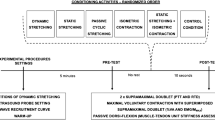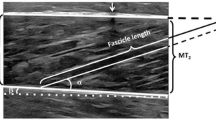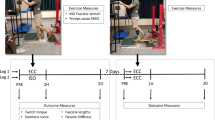Abstract
Purpose
We examined the effect of muscle stretching on the ability to produce rapid torque and the mechanisms underpinning the changes.
Methods
Eighteen men performed three conditions: (1) continuous stretch (1 set of 5 min), (2) intermittent stretch (5 sets of 1 min with 15-s inter-stretch interval), and (3) control. Isometric plantar flexor rate of torque development was measured during explosive maximal voluntary contractions (MVC) in the intervals 0–100 ms (RTDV100) and 0–200 ms (RTDV200), and in electrically evoked 0.5-s tetanic contractions (20 Hz, 20 Hz preceded by a doublet and 80 Hz). The rate of EMG rise, electromechanical delay during MVC (EMDV) and during a single twitch contraction (EMDtwitch) were assessed.
Results
RTDV200 was decreased (P < 0.05) immediately after continuous (− 15%) and intermittent stretch (− 30%) with no differences between protocols. The rate of torque development during tetanic stimulations was reduced (P < 0.05) immediately after continuous (− 8%) and intermittent stretch (− 10%), when averaged across stimulation frequencies. Lateral gastrocnemius rate of EMG rise was reduced after intermittent stretch (− 27%), and changes in triceps surae rate of EMG rise were correlated with changes in RTDV200 after both continuous (r = 0.64) and intermittent stretch (r = 0.65). EMDV increased immediately (31%) and 15 min (17%) after intermittent stretch and was correlated with changes in RTDV200 (r = − 0.56). EMDtwitch increased immediately after continuous (4%), and immediately (5.4%), 15 min (6.3%), and 30 min after (6.4%) intermittent stretch (P < 0.05).
Conclusions
Reductions in the rate of torque development immediately after stretching were associated with both neural and mechanical mechanisms.





Similar content being viewed by others
Abbreviations
- ANOVA:
-
Analysis of variance
- CI:
-
Confidence interval
- EMD:
-
Electromechanical delay
- EMDtwitch :
-
Electromechanical delay during the electrically evoked twitch
- EMDV :
-
Electromechanical delay during voluntary contraction
- EMG:
-
Electromyogram
- LG:
-
Lateral gastrocnemius
- M max :
-
Maximal compound action potential amplitude
- MVC:
-
Maximal voluntary contraction
- PICs:
-
Persistent inward currents
- RER:
-
Rate of electromyogram rise
- RFD:
-
Rate of force development
- RTD:
-
Rate of torque development
- RTDI :
-
Involuntary rate of torque development
- RTDV :
-
Voluntary rate of torque development
- SOL:
-
Soleus
- VFT:
-
Variable-frequency train of stimulation
References
Aagaard P, Simonsen EB, Andersen JL et al (2002) Increased rate of force development and neural drive of human skeletal muscle following resistance training. J Appl Physiol 93:1318–1326. https://doi.org/10.1152/japplphysiol.00283.2002
Abbate F, Bruton JD, De Haan A, Westerblad H (2002) Prolonged force increase following a high-frequency burst is not due to a sustained elevation of [Ca2+]i. Am J Physiol Physiol 283:C42–C47. https://doi.org/10.1152/ajpcell.00416.2001
Bakdash JZ, Marusich LR (2017) Repeated measures correlation. Front Psychol 8:1–13. https://doi.org/10.3389/fpsyg.2017.00456
Bakker AJ, Cully TR, Wingate CD et al (2017) Doublet stimulation increases Ca2+ binding to troponin C to ensure rapid force development in skeletal muscle. J Gen Physiol 149:323–334. https://doi.org/10.1085/jgp.201611727
Balog EM (2010) Excitation-contraction coupling and minor triadic proteins in low-frequency fatigue. Exerc Sport Sci Rev 38:135–142. https://doi.org/10.1097/JES.0b013e3181e3734d
Behm DG, Blazevich AJ, Kay AD, McHugh M (2016) Acute effects of muscle stretching on physical performance, range of motion, and injury incidence in healthy active individuals: a systematic review. Appl Physiol Nutr Metab 41:1–11. https://doi.org/10.1139/apnm-2015-0235
Bergquist AJ, Clair JM, Collins DF (2011) Motor unit recruitment when neuromuscular electrical stimulation is applied over a nerve trunk compared with a muscle belly: triceps surae. J Appl Physiol 110:627–637. https://doi.org/10.1152/japplphysiol.01103.2010
Binder-Macleod S, Kesar T (2005) Catchlike property of skeletal muscle: recent findings and clinical implications. Muscle Nerve 31:681–693. https://doi.org/10.1002/mus.20290
Blazevich AJ, Cannavan D, Waugh CM et al (2012) Neuromuscular factors influencing the maximum stretch limit of the human plantar flexors. J Appl Physiol 113:1446–1455. https://doi.org/10.1152/japplphysiol.00882.2012
Cavanagh PR, Komi PV (1979) Eletromechanical delay in human skeletal muscle under concentric and eccentric contractions. Eur J Appl Physiol 163:159–163
Cohen J (1988) Statistical power analysis for the behavioral sciences, 2nd edn. L. Erlbaum Associates, Hillsdale, N.J
Costa PB, Ryan ED, Herda TJ et al (2010) Acute effects of passive stretching on the electromechanical delay and evoked twitch properties: a gender comparison. J Appl Biomech 28:645–654. https://doi.org/10.1123/jab.28.6.645
de Ruiter CJ, Jones DA, Sargeant AJ, De Haan A (1999) Temperature effect on the rates of isometric force development and relaxation in the fresh and fatigued human adductor pollicis muscle. Exp Physiol 84:1137–1150
Desmedt BJE, Godaux E (1977) Ballistic contractions in man: characteristic recruitment pattern of single motor units of the tibialis anterior muscle. J Physiol 264:673–693
Duchateau J, Baudry S (2014) Maximal discharge rate of motor units determines the maximal rate of force development during ballistic contractions in human. Front Hum Neurosci 8:9–11. https://doi.org/10.3389/fnhum.2014.00234
Esposito F, Limonta E, Cè E (2011) Passive stretching effects on electromechanical delay and time course of recovery in human skeletal muscle: new insights from an electromyographic and mechanomyographic combined approach. Eur J Appl Physiol 111:485–495. https://doi.org/10.1007/s00421-010-1659-4
Heckman CJ, Enoka RM (2012) Motor unit. Compr Physiol 2:2629–2682. https://doi.org/10.1002/cphy.c100087
Jenkins NDM, Buckner SL, Cochrane KC et al (2014) Age-related differences in rates of torque development and rise in EMG are eliminated by normalization. Exp Gerontol 57:18–28. https://doi.org/10.1016/j.exger.2014.04.015
Kay AD, Blazevich AJ (2009) Moderate-duration static stretch reduces active and passive plantar flexor moment but not Achilles tendon stiffness or active muscle length. J Appl Physiol 106:1249–1256. https://doi.org/10.1152/japplphysiol.91476.2008
Kennedy DS, Fitzpatrick SC, Gandevia SC, Taylor JL (2015) Fatigue-related firing of muscle nociceptors reduces voluntary activation of ipsilateral but not contralateral lower limb muscles. J Appl Physiol 118:408–418. https://doi.org/10.1152/japplphysiol.00375.2014
Klass M, Baudry S, Duchateau J (2008) Age-related decline in rate of torque development is accompanied by lower maximal motor unit discharge frequency during fast contractions. J Appl Physiol 104:739–746. https://doi.org/10.1152/japplphysiol.00550.2007
Kudina LP, Andreeva RE (2010) Repetitive doublet Wring of motor units: evidence for plateau potentials in human motoneurons? Exp Brain Res 204:79–90. https://doi.org/10.1007/s00221-010-2298-z
Lanza MB, Balshaw TB, Folland JP (2017) MMAX normalisation of voluntary EMG removes the confounding influences of electrode location and body fat. Med Sci Sport Exerc 49:779. https://doi.org/10.1249/01.mss.0000519076.74034.cb
Maffiuletti NA, Aagaard P, Blazevich AJ et al (2016) Rate of force development: physiological and methodological considerations. Eur J Appl Physiol. https://doi.org/10.1007/s00421-016-3346-6
Martin V, Millet GY, Martin A et al (2004) Assessment of low-frequency fatigue with two methods of electrical stimulation. J Appl Physiol 97:1923–1929. https://doi.org/10.1152/japplphysiol.00376.2004
Morse CI, Degens H, Seynnes OR et al (2008) The acute effect of stretching on the passive stiffness of the human gastrocnemius muscle tendon unit. J Physiol 586:97–106. https://doi.org/10.1113/jphysiol.2007.140434
Nielsen BG (2009) Calcium and the role of motoneuronal doublets in skeletal muscle control. Eur Biophys J 38:159–173. https://doi.org/10.1007/s00249-008-0364-2
Nordez A, Gallot T, Catheline S et al (2009) Electromechanical delay revisited using very high frame rate ultrasound. J Appl Physiol 106:1970–1975. https://doi.org/10.1152/japplphysiol.00221.2009
Rodriguez-Falces J, Place N (2018) Determinants, analysis and interpretation of the muscle compound action potential (M wave) in humans: implications for the study of muscle fatigue. Eur J Appl Physiol 118:501–521. https://doi.org/10.1007/s00421-017-3788-5
Simic L, Sarabon N, Markovic G (2013) Does pre-exercise static stretching inhibit maximal muscular performance? A meta-analytical review. Scand J Med Sci Sport 23:131–148. https://doi.org/10.1111/j.1600-0838.2012.01444.x
Trajano GS, Nosaka K, Seitz L, Blazevich AJ (2014a) Intermittent stretch reduces force and central drive more than continuous stretch. Med Sci Sports Exerc 46:902–910. https://doi.org/10.1249/MSS.0000000000000185
Trajano GS, Seitz LB, Nosaka K, Blazevich AJ (2014b) Can passive stretch inhibit motoneuron facilitation in the human plantar flexors? J Appl Physiol 117:1486–1492. https://doi.org/10.1152/japplphysiol.00809.2014
Trajano GS, Nosaka K, Blazevich AJ (2017) Neurophysiological mechanisms underpinning stretch-induced force loss. Sport Med 47:1531–1541. https://doi.org/10.1007/s40279-017-0682-6
Un CP, Lin KH, Shiang TY et al (2013) Comparative and reliability studies of neuromechanical leg muscle performances of volleyball athletes in different divisions. Eur J Appl Physiol 113:457–466. https://doi.org/10.1007/s00421-012-2454-1
van Cutsem M, Duchateau J, Hainaut K (1998) Changes in single motor unit behaviour contribute to the increase in contraction speed after dynamic training in humans. J Physiol 1:295–305
Waugh CM, Korff T, Fath F, Blazevich AJ (2013) Rapid force production in children and adults. Med Sci Sport Exerc 45:762–771. https://doi.org/10.1249/mss.0b013e31827a67ba
Zhou S, Lawson DL, Morrison WE, Fairweather I (1995) Electromechanical delay in isometric muscle contractions evoked by voluntary, reflex and electrical stimulation. Eur J Appl Physiol Occup Physiol 70:138–145. https://doi.org/10.1007/BF00361541
Funding
This research received no specific grant from any funding agency in the public, commercial or not-for-profit sectors.
Author information
Authors and Affiliations
Contributions
GST and AJB conceived and designed the study. GST and LS conducted the experiments. GST analyzed the data, and drafted the first version of the manuscript. GST, LB, KN, and AJB critically revised the manuscript. All authors read and approved the manuscript.
Corresponding author
Ethics declarations
Conflict of interest
No conflicts of interest, financial or otherwise, are declared by the author(s).
Additional information
Communicated by Olivier Seynnes.
Publisher's Note
Springer Nature remains neutral with regard to jurisdictional claims in published maps and institutional affiliations.
Rights and permissions
About this article
Cite this article
Trajano, G.S., Seitz, L.B., Nosaka, K. et al. Passive muscle stretching impairs rapid force production and neuromuscular function in human plantar flexors. Eur J Appl Physiol 119, 2673–2684 (2019). https://doi.org/10.1007/s00421-019-04244-0
Received:
Accepted:
Published:
Issue Date:
DOI: https://doi.org/10.1007/s00421-019-04244-0




